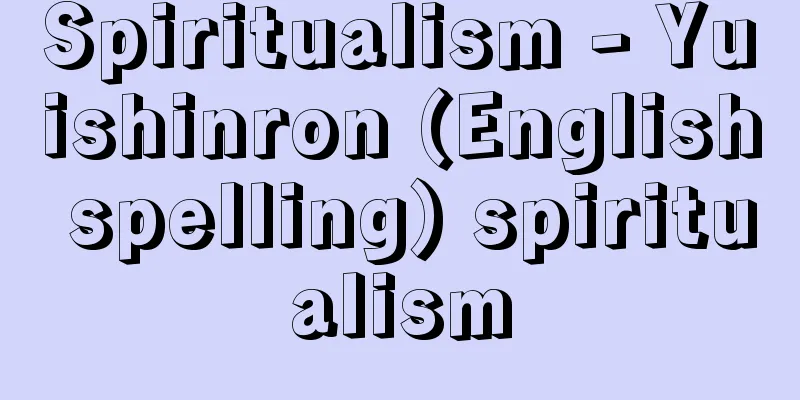Muso Soseki - Muso Soseki

|
A Rinzai sect monk from the Northern and Southern Courts to the early Muromachi period. Founder of the Muso school. His original name was Chikaku. He was from Ise (Mie Prefecture) and moved to Kai (Yamanashi Prefecture) at the age of four. He is said to have been a descendant of the Uda Genji clan. He first studied esoteric Buddhism under Kua at Heisei-san-ji Temple, and received full precepts at the Kaidan-in Temple of Todai-ji Temple at the age of 18. One day, he had a dream in which he was playing with Sozan and Sekitou from China, and changed his name to Soseki. In 1294 (Einin 2), he became a disciple of Muin Enpan (1230-1307) at Kennin-ji Temple and converted to Zen. He then visited Mukyou Tokusen, Ikou Dozen (1219-1302), Toukei Tokugo (1240-1307), Chidon Kusho, Issan Ichinei and others, and in 1300 (Shoan 2), he stayed at Nasu Ungan-ji Temple in Shimotsuke (Tochigi Prefecture). He then visited Takamine Kennichi at Manju-ji Temple in Kamakura and received his teachings, then retired to Mutsu (Aomori Prefecture) and Hitachi (Ibaraki Prefecture), before returning to Kamakura and presenting his enlightenment to Takamine at Jochi-ji Temple and receiving a seal of approval. However, he seems to have had a bad relationship with the teachers of the Bukko school led by Mugaku Sogen, and in 1313 (Showa 2) he went into hiding with Gen'o Hongen (1282-1332) at Nagaseyama (later Kokei-san Eiho-ji Temple) in Mino (Gifu Prefecture), and then moved to Yamashiro (Kyoto Prefecture) and Tosa (Kochi Prefecture). In 1319 (Gen'o 1), at the request of the wife of Hojo Sadatoki, he lived at Shoei-ji Temple in Kamakura, and also lived in Miura, Sagami (Kanagawa Prefecture), and Kazusa (Chiba Prefecture). In 1325 (Shochu 2), at the request of Emperor Godaigo, he entered Nanzen-ji Temple in Kyoto, but retired the following year in 1326 to found Zenno-ji Temple in Ise (Mie Prefecture), Zuisen-in Temple in Kamakura, and then entered Engaku-ji Temple. In 1330 (Gen'o 2), he founded Erin-ji Temple in Kai. In 1333 (Ganko 3/Shokei 2), at the request of Emperor Go-Daigo, he went to Kyoto and lived at Rinsen-ji Temple, which later became the headquarters of the Muso sect. The following year, 1334, he returned to Nanzen-ji Temple, and the following year, 1335, he was given the special title of Muso Kokushi. From this time on, he demonstrated his skillful political skills and led the Muso sect. Even after the failure of the Kenmu Restoration, he continued to receive the patronage of Ashikaga Takauji and Tadayoshi, and encouraged them to build Ankokuji Temple memorial towers throughout the country to mourn those who had died in war since the Genkō era. He also demonstrated his prowess by planning the construction of Tenryū-ji Temple to pray for the repose of Emperor Godaigo's soul, and by sending the Tenryū-ji ships to obtain funds for its construction. Tenryū-ji Temple was later ranked second among the Five Mountains of Japan. In 1345 (Kokoku 6, Sadawa 1), with the attendance of the retired Emperors Kogan and Komyo, he performed the 7th anniversary of Emperor Go-Daigo's death and the completion ceremony for Tenryu-ji Temple, and retired the following year in 1346, receiving the title of Shogaku Kokushi. In 1351 (Shohei 6, Kan'o 2), he returned to Tenryu-ji Temple and was given the title of Shinshu Kokushi by the retired Emperor Kogan. In the same year, he appointed the visiting monk Toryo Eiyo as his successor, and passed away on September 30th at Sanne-in Temple in Rinsen-ji Temple. His Zen style was different from pure Zen, and is said to have been influenced by Tendai and Shingon. He is said to have had 13,000 disciples, including many outstanding monks such as Mugoku Shigen (1282-1359), Shun'oku Myoha, Ryushu Shutaku (1308-1388), Gido Shushin, and Zekkaichi, and formed a major school (Muso school) in both political and literary fields among the Gozan school of the Muromachi period. He also enjoyed landscapes and mountains, and showed outstanding talent in landscape gardening at Saiho-ji Temple, Tenryu-ji Temple, Zuisen-ji Temple, and Eiho-ji Temple, greatly influencing Zen culture in later generations. Even after his death, he was given the titles of National Master Fusai, Genyu, Butsou, and Daien, and is commonly known as the "Imperial Master of the Seven Dynasties." In addition to his collection of sayings, he wrote works such as "Muchu Mondoshu," "Seizan Yawa," "Kokkyoshu," and "Wakashu." [Rikizan Ishikawa October 19, 2017] "Muso Mondoshu" (annotated and translated by Kawase Kazuma, Kodansha Bunko)" ▽ "Muso Kokushi - The Lineage of the Mainstream of Medieval Zen Temples" by Tamamura Takeji (1958, Heirakuji Shoten)" ▽ "Muso Kokushi - Zen and Gardens" by Kawase Kazuma (1968, Kodansha)" ▽ "Japanese Zen Sayings 7: Muso" by Yanagida Seizan (1977, Kodansha)" [References] | |Eiho- | |Takamine Myoha| | | | | |Rinsen-Gozanban Volume 1, Question by Ashikaga Tadayoshi, Answer by Muso Soseki, Published in the Muromachi Period, National Diet Library "A Collection of Enthralling Questions and Answers" ©Shogakukan "> Muso Soseki's signature Source: Shogakukan Encyclopedia Nipponica About Encyclopedia Nipponica Information | Legend |
|
南北朝から室町初期の臨済(りんざい)宗の僧。夢窓派の祖。初名は智(ちかく)。伊勢(いせ)(三重県)の人で、4歳で甲斐(かい)(山梨県)に移住。宇多(うだ)源氏の出身という。初め平塩山寺の空阿(くうあ)のもとで密教を学び、18歳のとき東大寺戒壇(かいだん)院で具足戒を受ける。あるとき、中国の疎山(そざん)と石頭(せきとう)に遊ぶ夢をみて疎石と改名した。 1294年(永仁2)建仁寺の無隠円範(むいんえんぱん)(1230―1307)に参じて禅に転じ、無及徳詮(むきゅうとくせん)、葦航道然(いこうどうねん)(1219―1302)、桃渓徳悟(とうけいとくご)(1240―1307)、痴鈍空性(ちどんくうしょう)、一山一寧(いっさんいちねい)らに歴参、1300年(正安2)下野(しもつけ)(栃木県)那須雲巌(なすうんがん)寺にとどまる。ついで鎌倉万寿(まんじゅ)寺の高峰顕日(こうほうけんにち)を訪ねて教えを受けたのち、陸奥(むつ)(青森県)、常陸(ひたち)(茨城県)に隠棲(いんせい)、ふたたび鎌倉に帰り浄智寺の高峰に所悟(しょご)を呈して印可(いんか)を受けた。ただし無学祖元(むがくそげん)の仏光(ぶっこう)派の諸師とはその後の折り合いが悪かったらしく、1313年(正和2)美濃(みの)(岐阜県)長瀬山(後の虎渓(こけい)山永保(えいほう)寺)に元翁本元(げんのうほんげん)(1282―1332)とともに隠れ、さらに山城(やましろ)(京都府)、土佐(高知県)に移住した。1319年(元応1)北条貞時(ほうじょうさだとき)夫人の請(しょう)により鎌倉の勝栄寺に寓居(ぐうきょ)、相模(さがみ)(神奈川県)三浦、上総(かずさ)(千葉県)に庵居(あんきょ)する。1325年(正中2)後醍醐(ごだいご)天皇の請により京都の南禅寺に入寺したが、翌1326年退き、伊勢(いせ)(三重県)の善応寺、鎌倉の瑞泉(ずいせん)院(寺)を開き、さらに円覚(えんがく)寺に入寺、1330年(元徳2)には甲斐恵林(えりん)寺を開いた。 1333年(元弘3・正慶2)後醍醐天皇の請により上洛(じょうらく)して臨川(りんせん)寺に住したが、ここはのちに夢窓派の本拠となった。翌1334年、南禅寺に再住、さらに翌1335年には夢窓国師の号を特賜(とくし)された。このころより巧妙な政治的手腕を発揮して夢窓派を統率する。建武(けんむ)新政の挫折(ざせつ)後も足利尊氏(あしかがたかうじ)・直義(ただよし)の外護(げご)を受け、元弘(げんこう)以来の戦没者を弔うため尊氏・直義に勧めて全国に安国寺利生塔(あんこくじりしょうとう)を創設し、また後醍醐天皇の冥福(めいふく)を祈るために天竜寺の建立を図り、天竜寺船を出帆させてその造営の資を得るなど、その手腕を振るった。天竜寺はのちに五山第二位に列せられた。1345年(興国6・貞和1)光巌(こうごん)上皇・光明(こうみょう)天皇臨幸のもとに後醍醐天皇七周忌および天竜寺落慶仏事を行い、翌1346年退席、正覚(しょうがく)国師の号を賜った。1351年(正平6・観応2)天竜寺に再住、光巌上皇より心宗(しんしゅう)国師の号を賜る。同年、来朝僧東陵永璵(とうりょうえいよ)に後席を委嘱し、9月30日臨川寺三会(さんね)院において示寂。 彼の禅風は純粋禅とは異なり、天台・真言(しんごん)を加味したものであったといわれる。門人は俗に1万3000人といわれるが、無極志玄(むごくしげん)(1282―1359)、春屋妙葩(しゅんおくみょうは)、竜湫周沢(りょうしゅうしゅうたく)(1308―1388)、義堂周信(ぎどうしゅうしん)、絶海中津(ぜっかいちゅうしん)ら多くの傑僧俊秀が輩出し、室町期の五山派のなかで政治的にも文芸面でも一大門派(夢窓派)を形成した。また山水を賞翫(しょうがん)し、西芳(さいほう)寺、天竜寺、瑞泉(ずいせん)寺、永保寺などの造園にも卓抜した才能を発揮し、後世の禅文化に大きな影響を与えた。没後も、普済(ふさい)、玄猷(げんゆう)、仏統、大円の国師号を賜り、俗に「七朝(しちちょう)の帝師」とよばれる。語録のほか、『夢中(むちゅう)問答集』『西山(せいざん)夜話』『谷響(こっきょう)集』『和歌集』などの著述がある。 [石川力山 2017年10月19日] 『川瀬一馬校注・訳『夢中問答集』(講談社文庫)』▽『玉村竹二著『夢窓国師――中世禅林主流の系譜』(1958・平楽寺書店)』▽『川瀬一馬著『夢窓国師――禅と庭園』(1968・講談社)』▽『柳田聖山著『日本の禅語録 7 夢窓』(1977・講談社)』 [参照項目] | | | | | | | | | | | |五山版 巻1 足利直義問 夢窓疎石答 室町時代刊国立国会図書館所蔵"> 『夢中問答集』 ©Shogakukan"> 夢窓疎石花押 出典 小学館 日本大百科全書(ニッポニカ)日本大百科全書(ニッポニカ)について 情報 | 凡例 |
Recommend
Ornament - Ornament
It refers to decorations, ornaments, ornamental it...
Organization of Arab Petroleum Exporting Countries (English)
Abbreviated as OAPEC, it was established on Janua...
Pennines (English spelling)
A mountain range that runs north to south through ...
Reverse osmosis process
When a solution and a solvent come into contact w...
Kinpusenji Temple
It is the head temple of Kinpusen-san Shugen Hons...
Oobeniuchiwa - Oobeniuchiwa
...An evergreen herb of the Araceae family with o...
Fool - Gusha
〘 noun 〙 A foolish person. Idiot. ⇔ A wise man. ※S...
Sir Sanford
…It runs approximately 320 km north to south, alm...
Claws - Claws
…The terminal segment is a movable finger that in...
Exchange dumping
Dumping originally meant buying and selling at di...
Rice caterpillar - Rice caterpillar
The common name for the larvae of the two-banded ...
Hollowing phenomenon - Hollowing phenomenon
...This is a phenomenon in which the permanent po...
Vitis flexuosa
A deciduous climbing plant of the Vitaceae family....
Mulhacen, Cerro de (English spelling) Mulhacen Cerrode
… [Naoko Kurihara]. … *Some of the terminology th...
Cultivation rights
Generally speaking, it refers to the rights that ...









